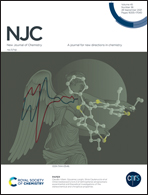Oriented attachment induced morphology modulation of ZnO nanoparticles at low temperature using KOH as a morphology controller†
Abstract
ZnO nanoparticles (NPs) of quasi-spherical and rod shape were synthesized following a low-temperature chemical route by varying the primary environment with KOH concentration as the controlling parameter. The ratios of precursor to KOH concentration in solution considered were 1 : 1.5, 1 : 2, 1 : 2.5, 1 : 3, 1 : 3.5, and 1 : 4. The precursor to KOH concentration ratio of 1 : 2 was found to be the threshold ratio for the synthesis of ZnO NPs. From the precursor to KOH ratios of 1 : 2 to 1 : 3, quasi-spherical shaped ZnO NPs were formed. Additionally, for the precursor to KOH ratio of 1 : 3, faceted and anisotropic ZnO NPs were also observed for larger particles, which showed a clear indication of shape deformation from sphere to rod. For the last sample (precursor : KOH = 1 : 4), all the ZnO NPs were in the form of nanorods. The optical band gap and photoluminescence emission bands were seen to change with the change in NP morphology, and especially abrupt changes in optical properties were observed at a ratio of precursor to KOH of 1 : 3, which is in conformity with the shape deformation of the ZnO NPs. It is argued that the observed shape transition was mainly due to the oriented attachment (OA) of ZnO NPs. The OH− ions in the solution get strongly attracted by the Zn-terminated surfaces of ZnO NPs. Due to such attraction, the charge distribution on the surface of the NPs would become asymmetric, favoring OA. For a lower KOH concentrations, the number density of OH− ions had a small value, which led to a lower probability of intermolecular reaction than intramolecular reaction. Hence, the growth of NPs took place slowly and not preferentially towards a particular direction. For higher KOH concentrations, the number density of OH− ions had a higher value, leading to a higher probability of intermolecular reactions, resulting in anisotropic growth. Also, when the concentration of K+ ions, surrounding ZnO NPs, has attained some specific level, the forces controlling OA could reach some specific value. At such a specific value of OA controlling forces, OA between the ZnO NPs could be initiated. Also, a combination of intrinsic interactions among NPs, such as dipole–dipole interactions and interactions caused by the solvent, could induce OA. The KOH concentration influenced the driving forces causing OA among the ZnO NPs, leading to nanorods.



 Please wait while we load your content...
Please wait while we load your content...